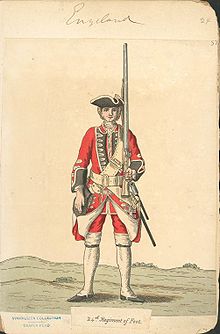Redcoat

Redcoat ( English Red Coat ) is an informal name for members of the British Army . The somewhat antiquated term is used in Ireland to refer to the British security forces and sometimes all British . The term is also used for the Royal Canadian Mounted Police and other red uniformed troops of the British Commonwealth . Especially in the American War of Independence , the term red coat was used disparagingly for the British troops.
history
A characteristic piece of clothing for British soldiers (especially the infantry) from the end of the 17th century until the introduction of camouflage clothing was a red uniform skirt . This brought them, especially in North America, the nickname red coats, which had pejorative connotations from the American War of Independence . Even the name Lobster hump ( English lobster backs ) alluded to the color of the uniform.
The red uniform skirt was initially only worn by the Yeomen Warders and the Yeomen of the Guard until the New Model Army was founded in February 1645 . From this point on, the British infantry were largely dressed in red uniform skirts. The red was initially only used by Cromwell's republican troops , but the army continued to use the color even after the Restoration in 1660, which is due to the relatively inexpensive production of the red dye at the time.
The cut of uniform skirts changed with fashion, but the regiments mostly kept their traditional badge colors .
From the middle of the 19th century onwards, khaki-colored uniforms increasingly replaced the “colorful skirt” in the colonies ; the last battle in the red skirt took place on December 30, 1885 at the Battle of Ginnis . In 1902, a khaki-colored uniform was introduced throughout the British army for field service in the motherland, the red skirt was only used as a full dress (parade or large service suit). During the First World War it was no longer issued to most of the recruits.
From 1920, for cost reasons, the red skirt was only allowed to be worn as a gala uniform by the five guards infantry regiments , the life guards , the military musicians and officers. Exceptions are made at weddings and in court. Now that the uniform cloth could be dyed inexpensively with chemical agents instead of expensive carmine , plans were made to reintroduce the red skirt as a replacement for the blue No. 1 dress and the khaki No. 2 dress in the 1980s . However, this project met with little approval from the troops and was therefore not carried out.
The red coat is also still in use as a parade uniform for some units of the armed forces and security forces of the Commonwealth of Canada , Australia , Jamaica , New Zealand , Fiji , Pakistan , Ghana and Singapore as well as the Crown Colony of Gibraltar ( Royal Gibraltar Regiment ).
See also
Individual evidence
- ^ WY Carman: British Military Uniforms from Contemporary Pictures . Hamlyn Publishing Group Ltd, 1957, ISBN 0-600-00348-5 (English).
- ^ WY Carman: Uniforms of the British Army - the Infantry Regiments . ISBN 0-86350-031-5 , pp. 33 .
- ↑ Philip J. Haythornthwaite: The Colonial Wars Sourcebook . Arms and Armor Press, London 1995, ISBN 1-85409-196-4 , pp. 35 .
